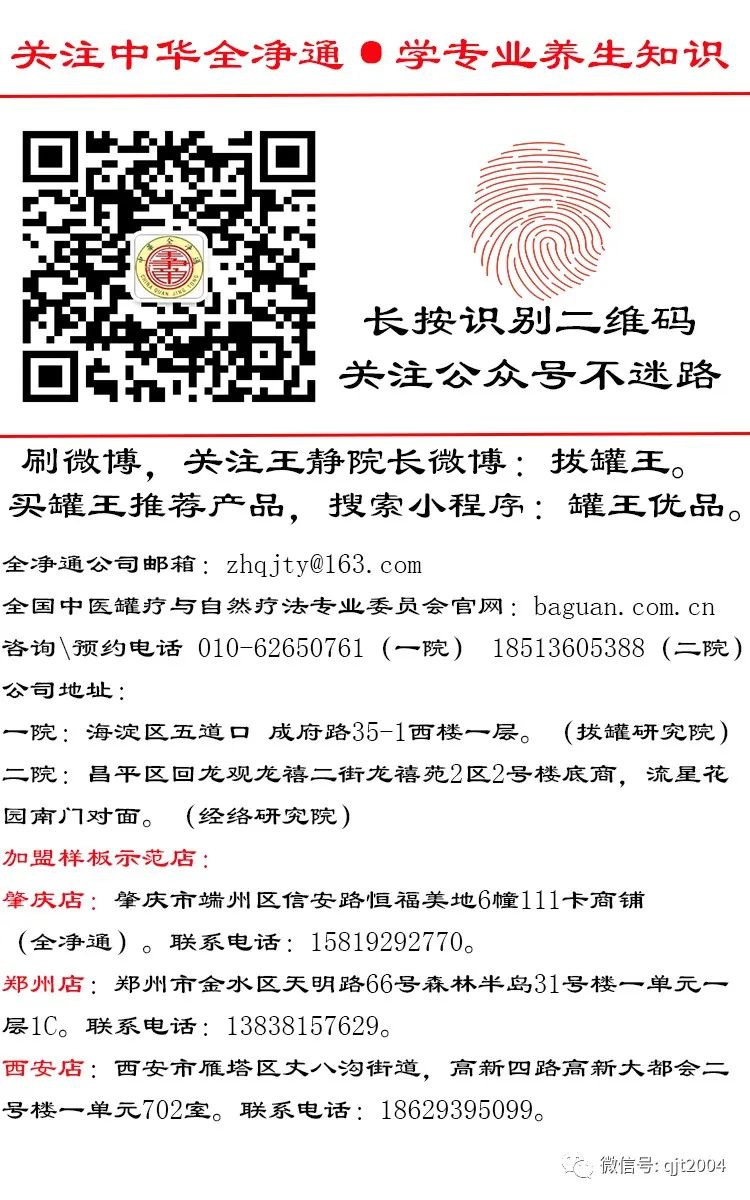People around the world are interested in Quan Jing Tong
Follow me for daily knowledge updates
Many people have similar experiences, especially drivers, students, and office workers, who often suffer from lower back pain due to prolonged sitting or poor posture. Lower back pain is particularly common among the elderly. As a prevalent form of sub-health, lower back pain severely affects people’s quality of life, causing significant distress. Today, Quan Jing Tong will discuss simple methods to relieve lower back pain through cupping therapy.
First: Universal Cupping Method for Lower Back Pain
First, locate five acupuncture points: Shenzhong (脊中穴), Zuobaimai (左带脉), Youbaimai (右带脉), Changqiang (长强穴), and Mingmen (命门穴) (or Yaoyangguan (腰阳关穴) can also be used), and then apply cupping to these five points.
Acupuncture Point One: Shenzhong (脊中穴): Located on the back, at the depression below the spinous process of the eleventh thoracic vertebra along the posterior midline, it is a commonly used point for back pain.
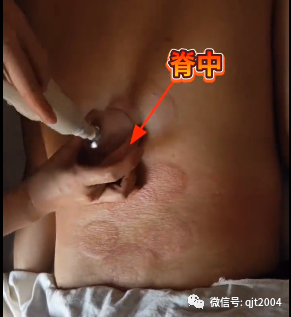
Acupuncture Points Two/Three: Zuobaimai (带脉穴): Located on the side of the abdomen, at the intersection of the vertical line below the free end of the eleventh rib and the horizontal line of the navel, it is the intersection point of the Gallbladder Meridian (足少阳胆经) and the Dai Mai (带脉, one of the extraordinary meridians).

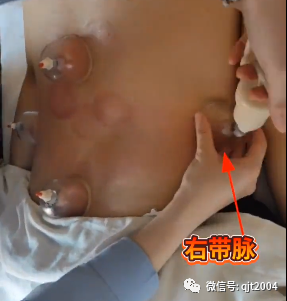
Acupuncture Point Four: Changqiang (长强穴): Located at the midpoint of the line connecting the tailbone and the anus.

Acupuncture Point Five: Mingmen (命门穴): Located at the waist area, near Yaoyangguan. This point can also be cupped on either side of Mingmen.
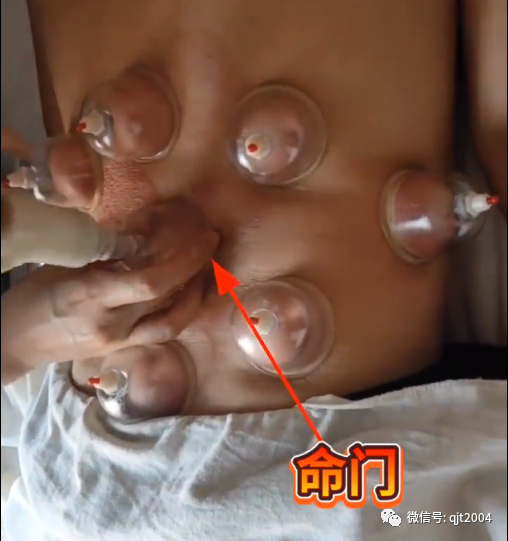
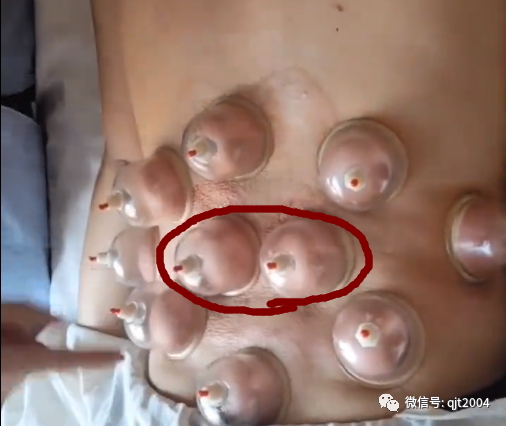
Second: Three Common Cupping Methods for Lower Back Pain
Additionally, there are three different cupping methods for treating lower back pain in Traditional Chinese Medicine.
1. Kidney Deficiency Lower Back Pain
For cupping, smaller cups are used for tonification, while larger cups are used for dispersing; a weaker suction is for tonification, while a stronger suction is for dispersing; shorter suction time is for tonification, while longer suction time is for dispersing; superficial suction is for tonification, while deep suction is for dispersing; gentle suction with small movements is for tonification, while strong suction with large movements is for dispersing; fewer suction points are for tonification, while more suction points are for dispersing; methods in between are for balanced tonification and dispersing.
① Treatment Principle: For Yang deficiency, tonify the kidney and support Yang; for Yin deficiency, tonify the kidney and nourish Yin.
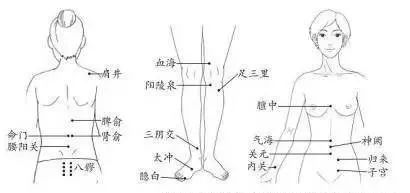
② Acupuncture Points: For Yang deficiency: Dachangshu (大肠腧), Huantiao (环跳), Weizhong (委中), Shenshu (肾俞), Zusanshi (足三里), Kunlun (昆仑), Mingmen (命门), Qihai (气海), Guanyuan (关元). For Yin deficiency: Dachangshu (大肠腧), Huantiao (环跳), Weizhong (委中), Zhibian (秩边), SanYinjiao (三阴交), Taixi (太溪), Mingmen (命门), Qihai (气海), Guanyuan (关元). Zusanshi (足三里) is the meeting point of the Stomach Meridian (足阳明胃之合), and Kunlun (昆仑) is a point on the Bladder Meridian (足太阳膀胱经), paired with Shenshu (肾俞) to warm the meridians and relieve pain. SanYinjiao (三阴交) paired with Taixi (太溪) nourishes the Yin of the Liver, Spleen, and Kidney.
③ Procedure: The patient lies face down, select points Shenshu (肾俞), Dachangshu (大肠腧), Weizhong (委中), Zusanshi (足三里), using the smallest cupping device to cup Kunlun (昆仑). Do not exceed five cups per session, using medium to small-sized cups, starting with moving the cups and then leaving them in place. The suction should not be too strong, and the duration should be 5-10 minutes, rotating the points daily.
2. Wind-Damp Lower Back Pain
① Treatment Principle: Warm the meridians and unblock the collaterals to relieve pain.
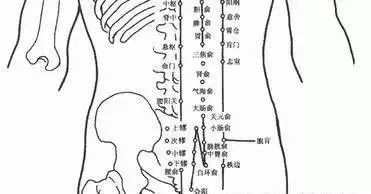
② Acupuncture Points: Shenshu (肾俞), Zhishi (志室), Qihai (气海俞), Dachangshu (大肠腧), Guanyuan (关元俞), Huantiao (环跳), Fengshi (风实), Weizhong (委中), Yanglingquan (阳陵泉), Feiyang (飞扬), Kunlun (昆仑).
③ Procedure: The patient lies face down, using medium to large-sized cups, applying suction for 10-15 minutes. Only Kunlun (昆仑) should use the smallest cup. The number of cups is unlimited, and cupping can be performed simultaneously on the above points. Additionally, use lubricating oil to glide the cups from top to bottom, and local wind-damp stagnation can be pricked.
3. Blood Stasis Lower Back Pain
① Treatment Principle: Invigorate blood circulation, dispel stasis, and relieve pain.
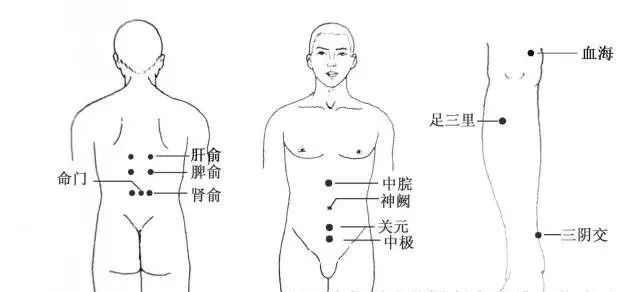
② Acupuncture Points: Xuehai (血海), Ge Shu (膈腧), Dachangshu (大肠腧), Huantiao (环跳), SanYinjiao (三阴交), Hegu (合谷), Qimen (期门), Shenshu (肾俞), Zhibian (秩边), Chengshan (承山).
③ Procedure: The patient lies face down, using medium to large-sized cups, applying deep suction for 10-15 minutes, extending the time as needed. It is best to draw out the sha (瘀血), and when using oil, employ a spiral motion with a large amplitude. Cupping on Huantiao (环跳), Dachangshu (大肠腧), Weizhong (委中), and Chengshan (承山) can be done using the flash cupping method for acute pain, providing immediate relief. Do not exceed three acupuncture points per session, and women can use two points.
Third: Regular Practice of Lower Back Health Exercises
Relieving lower back pain requires long-term commitment; it cannot be eradicated in just a few days. Regular practice of the following lower back health exercises can strengthen the lower back:
Waist Rubbing
👟 Steps: Also known as “rubbing the inner kidney,” rub both hands together to warm them, then gently and quickly rub the sides of the lower back 18 times.
👟 Function: Rubbing the waist promotes blood circulation in the lower back, alleviates muscle spasms, strengthens the waist and kidneys, and prevents and treats lower back pain, dysmenorrhea, impotence, premature ejaculation, and other conditions.
Twisting Rotation
👟 Steps:
1. Starting Position: Stand with legs apart, slightly wider than shoulder-width; bend both arms, hands on hips, thumbs facing forward; keep eyes looking straight ahead.
2. Use both hands to push the pelvis in a clockwise direction, completing one full rotation, performing 1-2 sets of eight beats.
3. Repeat the above actions in the opposite direction.
👟 Key Points: The waist should rotate as much as possible, while the head and upper body should move minimally. Ensure the lumbar spine moves smoothly and continuously without interruption. Keep the legs straight without bending the knees, avoiding a “nodding” posture. At the fourth and eighth beats, relax the shoulder and waist muscles to achieve a balance of tension and relaxation, aiming for a noticeable sensation of soreness and fullness in the waist.
👟 Function: Suitable for patients with chronic lumbar muscle strain and sacroiliac joint strain.
